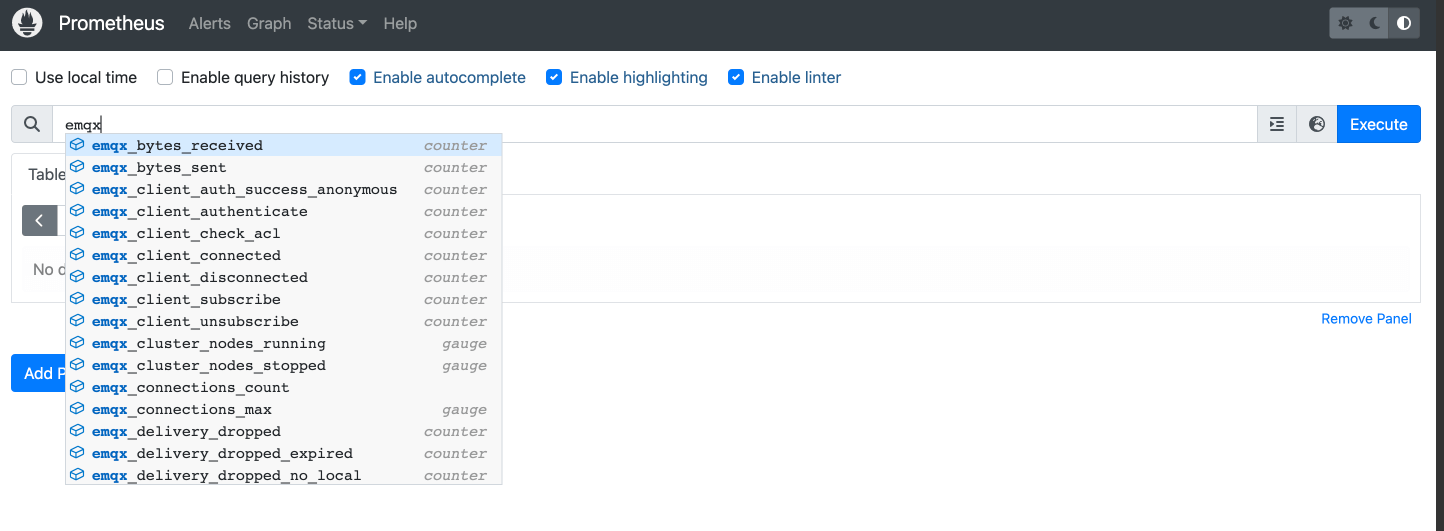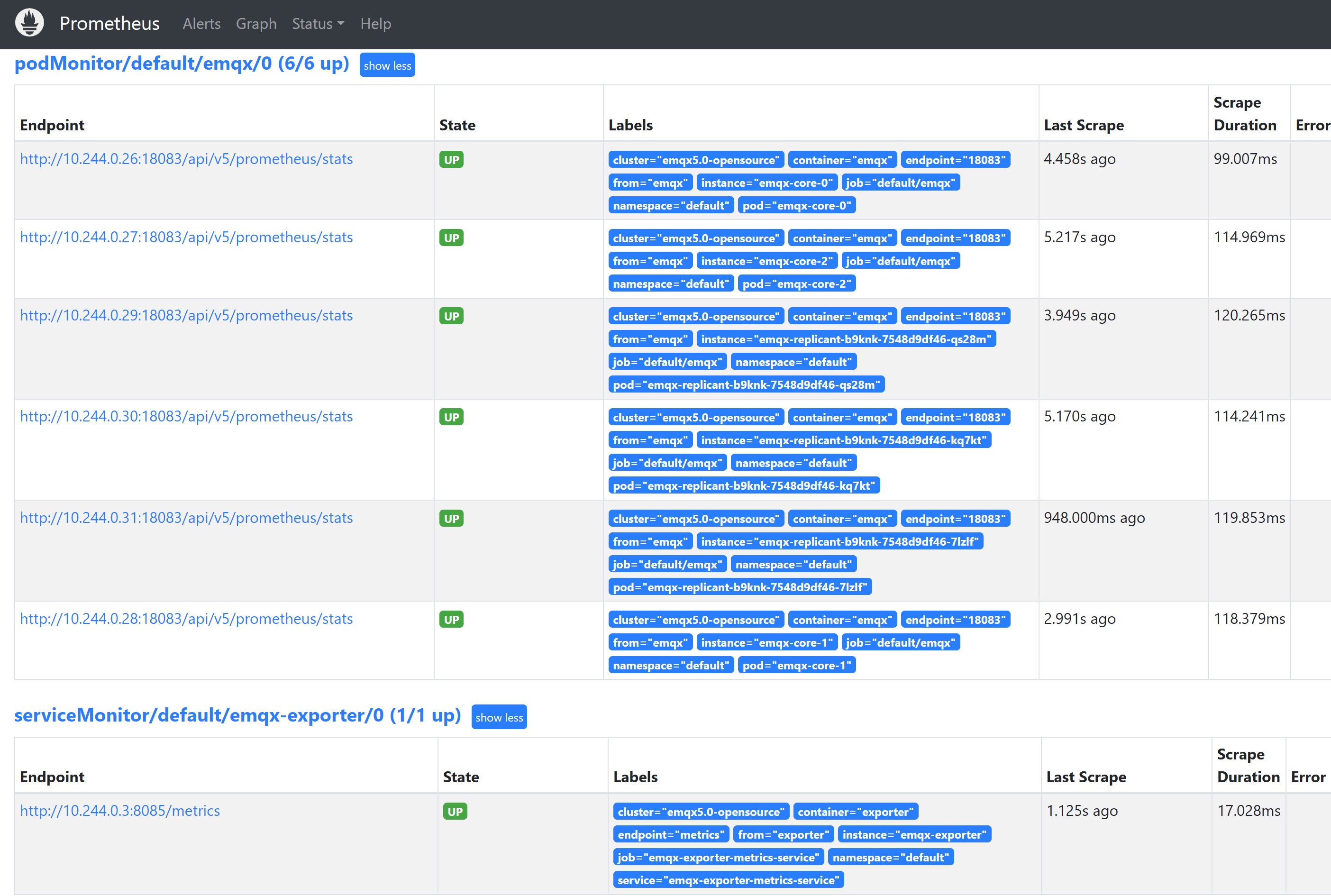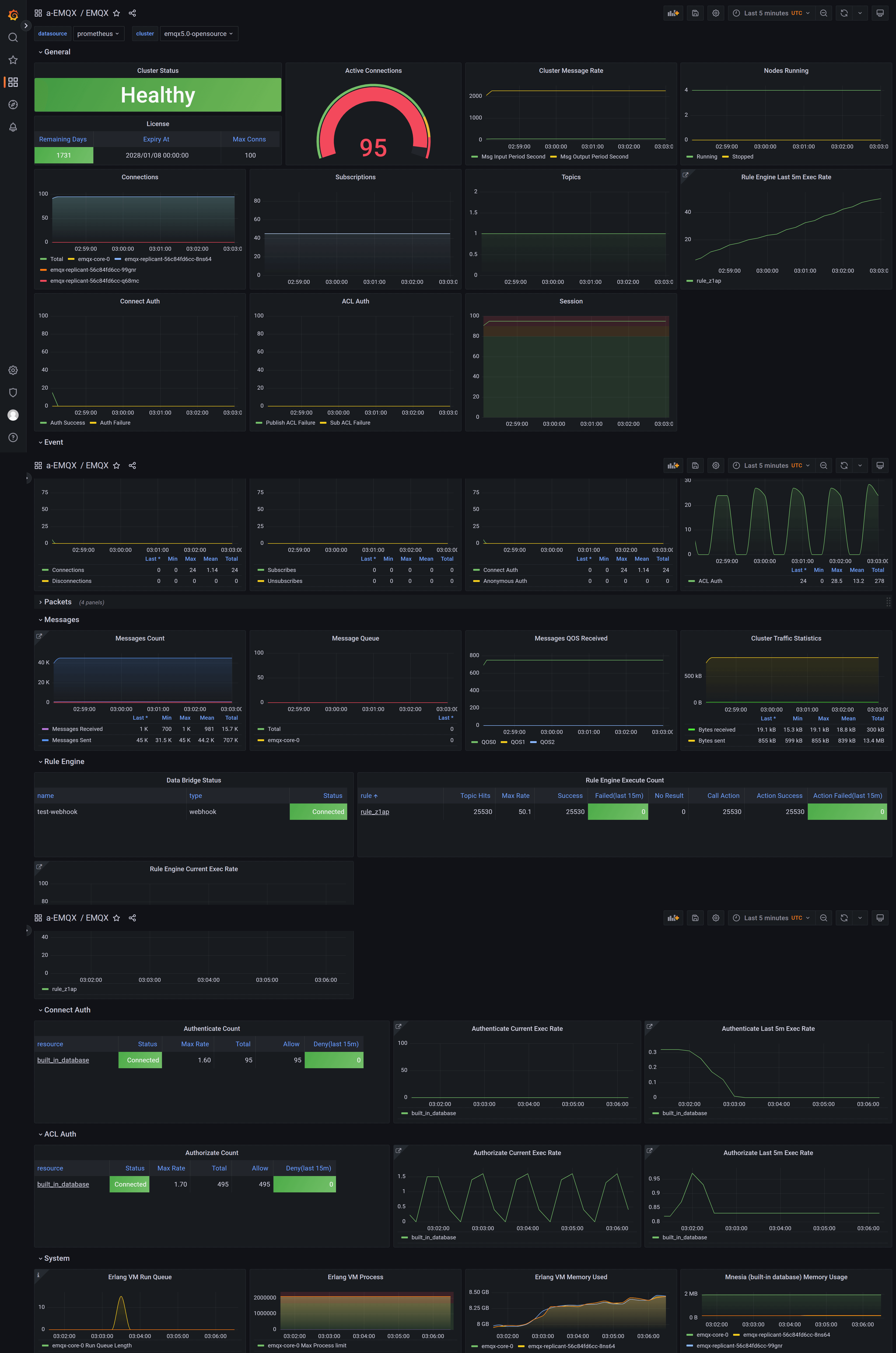Monitor EMQX cluster by Prometheus and Grafana
Task Target
Deploy EMQX Exporter and monitor EMQX cluster by Prometheus and Grafana.
Deploy Prometheus and Grafana
Prometheus' deployment documentation can refer to Prometheus Grafana' deployment documentation can refer to Grafana
Deploy EMQX Cluster
Here are the relevant configurations for EMQX Custom Resource. You can choose the corresponding APIVersion based on the version of EMQX you wish to deploy. For specific compatibility relationships, please refer to EMQX Operator Compatibility:
EMQX supports exposing indicators through the http interface. For all statistical indicators under the cluster, please refer to the document: Integrate with Prometheus
apiVersion: apps.emqx.io/v2beta1
kind: EMQX
metadata:
name: emqx
spec:
image: emqx/emqx-enterprise:6.0.1
config:
data: |
license {
key = "..."
}Save the above content as emqx.yaml and execute the following command to deploy the EMQX cluster:
$ kubectl apply -f emqx.yaml
emqx.apps.emqx.io/emqx createdCheck the status of the EMQX cluster and make sure that STATUS is Running, which may take some time to wait for the EMQX cluster to be ready.
$ kubectl get emqx emqx
NAME IMAGE STATUS AGE
emqx emqx/emqx-enterprise:6.0.1 Running 10mCreate API Secret
emqx-exporter and Prometheus will pull metrics from EMQX dashboard API, so you need to sign in to dashboard to create an API Key.
Deploy EMQX Exporter
The emqx-exporter is designed to expose partial metrics that are not included in the EMQX Prometheus API.
apiVersion: v1
kind: Service
metadata:
labels:
app: emqx-exporter
name: emqx-exporter-service
spec:
ports:
- name: metrics
port: 8085
targetPort: metrics
selector:
app: emqx-exporter
---
apiVersion: apps/v1
kind: Deployment
metadata:
name: emqx-exporter
labels:
app: emqx-exporter
spec:
selector:
matchLabels:
app: emqx-exporter
replicas: 1
template:
metadata:
labels:
app: emqx-exporter
spec:
securityContext:
runAsUser: 1000
containers:
- name: exporter
image: emqx-exporter:latest
imagePullPolicy: IfNotPresent
args:
# "emqx-dashboard-service-name" is the service name that creating by operator for exposing 18083 port
- --emqx.nodes=${emqx-dashboard-service-name}:18083
- --emqx.auth-username=${paste_your_new_api_key_here}
- --emqx.auth-password=${paste_your_new_secret_here}
securityContext:
allowPrivilegeEscalation: false
runAsNonRoot: true
ports:
- containerPort: 8085
name: metrics
protocol: TCP
resources:
limits:
cpu: 100m
memory: 100Mi
requests:
cpu: 100m
memory: 20MiSet the arg "--emqx.nodes" to the service name that creating by operator for exposing 18083 port. Check out the service name by call
kubectl get svc.
Save the above content as emqx-exporter.yaml, replace --emqx.auth-username and --emqx.auth-password with your new creating API secret, then execute the following command to deploy the emqx-exporter:
kubectl apply -f emqx-exporter.yamlCheck the status of emqx-exporter pod。
$ kubectl get po -l="app=emqx-exporter"
NAME STATUS AGE
emqx-exporter-856564c95-j4q5v Running 8m33sConfigure Prometheus Monitor
Prometheus-operator uses PodMonitor and ServiceMonitor CRD to define how to monitor a set of pods or services dynamically.
apiVersion: monitoring.coreos.com/v1
kind: PodMonitor
metadata:
name: emqx
labels:
app.kubernetes.io/name: emqx
spec:
podMetricsEndpoints:
- interval: 5s
path: /api/v5/prometheus/stats
# the name of emqx dashboard containerPort
port: dashboard
relabelings:
- action: replace
# user-defined cluster name, requires unique
replacement: emqx5
targetLabel: cluster
- action: replace
# fix value, don't modify
replacement: emqx
targetLabel: from
- action: replace
# fix value, don't modify
sourceLabels: ['pod']
targetLabel: "instance"
selector:
matchLabels:
# the label is the same as the label of emqx pod
apps.emqx.io/instance: emqx
apps.emqx.io/managed-by: emqx-operator
namespaceSelector:
matchNames:
# modify the namespace if your EMQX cluster deployed in other namespace
#- default
---
apiVersion: monitoring.coreos.com/v1
kind: ServiceMonitor
metadata:
name: emqx-exporter
labels:
app: emqx-exporter
spec:
selector:
matchLabels:
# the label is the same as the label of emqx exporter svc
app: emqx-exporter
endpoints:
- port: metrics
interval: 5s
path: /metrics
relabelings:
- action: replace
# user-defined cluster name, requires unique
replacement: emqx5
targetLabel: cluster
- action: replace
# fix value, don't modify
replacement: exporter
targetLabel: from
- action: replace
# fix value, don't modify
sourceLabels: ['pod']
regex: '(.*)-.*-.*'
replacement: $1
targetLabel: "instance"
- action: labeldrop
# fix value, don't modify
regex: 'pod'
namespaceSelector:
matchNames:
# modify the namespace if your exporter deployed in other namespace
#- default`path` indicates the path of the indicator collection interface. In EMQX 5, the path is: `/api/v5/prometheus/stats`. `selector.matchLabels` indicates the label of the matching Pod: `apps.emqx.io/instance: emqx`.
The value of targetLabel `cluster` represents the name of current cluster, make sure its uniqueness.
Save the above content as monitor.yaml and execute the following command:
$ kubectl apply -f monitor.yamlView EMQX Indicators on Prometheus
Open the Prometheus interface, switch to the Graph page, and enter emqx to display as shown in the following figure:

Switch to the Status -> Targets page, the following figure is displayed, and you can see all monitored EMQX Pod information in the cluster:

Import Grafana Templates
Import all dashboard templates. Open the main dashboard EMQX and enjoy yourself!
